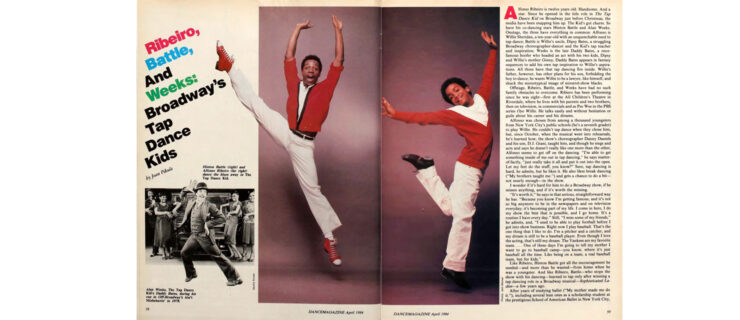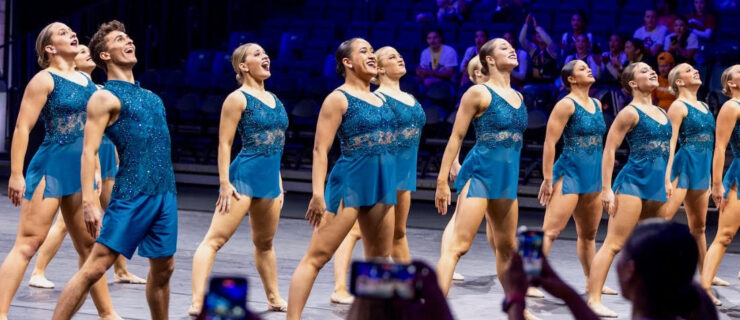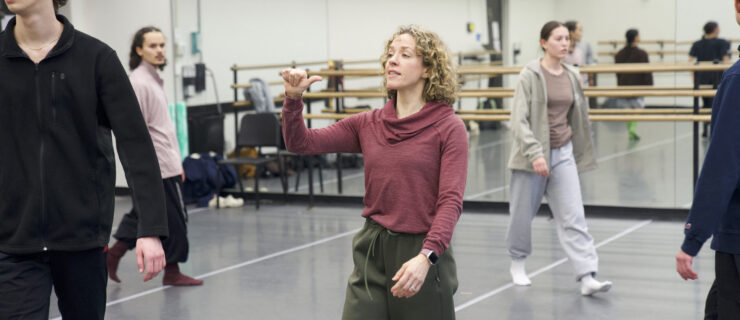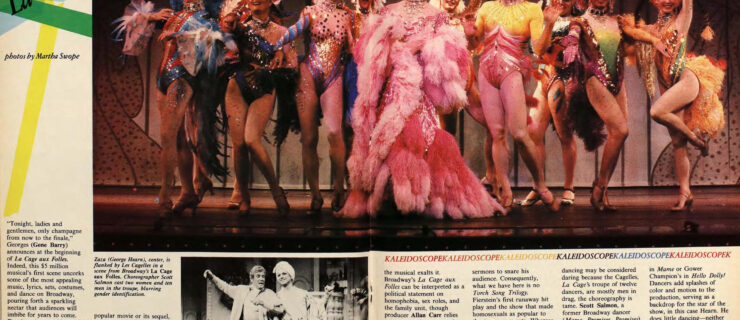Stars Over Texas
When Stanton Welch became artistic director of Houston Ballet eight years ago, the company’s board challenged him to dream big.
A tangible response now sparkles in black granite and glass on the northern edge of Houston’s theater district. The company’s sleek, airy $46.6 million Center for Dance, which opened in April, gives Houston Ballet and its Ben Stevenson Academy a fantastic, six-story home. Its 115,000 square feet make it the nation’s largest dedicated dance building. Within are nine studios; a black-box theater; a dormitory; a large communal lounge flooded with daylight; a huge wardrobe shop; libraries; an abundance of offices; and a covered crosswalk to the backstage at the Wortham Theater Center, where they perform.
Earlier in the year, surrounded by boxes and mementos in his old office, Welch spoke with a sense of authority he didn’t have in 2003. His chats aren’t punctuated with nervous laughter anymore.
The new building, he said, “is bigger than all of us. It’s a monument to how far we’ve come and how much support classical ballet has had in Houston.”
The building’s architects have called it a billboard for the art form because passersby can view classes and rehearsals through long, horizontal swaths of floor-to-ceiling windows. For the company, Welch said, the building signifies a new level of maturity. Their growth is also evident—less tangibly—in the studios and onstage.
“We really feel we’re at our boil,” Welch said.
The charismatic Ben Stevenson had nurtured the company the previous 27 years, building it into the nation’s fifth largest ballet troupe, with 50 dancers, four apprentices, a $13 million annual budget, and a fine opera house. He also developed the company’s school and drew talent to a city once considered a ballet backwater. He lured Janie Parker from Ballet du Grand Théâtre de Genève, Balanchine’s Swiss company, brought Li Cunxin from China (a story compellingly told in Mao’s Last Dancer), showcased Carlos Acosta, and enticed Nina Ananiashvili to guest-star.
Stevenson produced lavish story ballets like clockwork, balancing his repertoire with contemporary masterworks (MacMillan’s Gloria and Balanchine’s Serenade among them) and commissioning new dances from the likes of Christopher Bruce (who’s been associated with the company since the 1980s), Paul Taylor, and Glen Tetley, as well as younger talents like Welch and Trey McIntyre.
From that foundation, Welch envisioned building a company that wasn’t just internationally known but also world-class. A few rocky transitional years of personnel change ensued, but the company’s ranks are now rich with fresh talent. Welch’s focus on acquiring “landmark” ballets has kept the dancers on their toes and dramatically altered the company’s aesthetic.
He has packed his seven-program seasons with company premieres or long- overdue revivals of contemporary masterworks he felt were missing from the dancers’ bones—including such hits as Tharp’s In the Upper Room, Balanchine’s Apollo and Jewels, Robbins’ The Concert and Fancy Free, Kylián’s Petite Mort, Mark Morris’ Sandpaper Ballet, and Nacho Duato’s Jardí Tancat.
“They’re ballets that have changed the world of dance,” he said. “It’s important to keep our dancers inspired. You want them to look at the list every year and think, ‘I can’t wait to do that.’ ”
His choices have resonated with audiences, too—and camouflaged recession-era budgets. “When I arrived we had a repertoire that was 70 percent Ben. We couldn’t afford to just click our fingers and change the entire rep list, but we have over the last seven years,” Welch said.
The current mixed-rep program (May 26–June 5), aptly titled “Raising the Barre,” features a world premiere by Jorma Elo and the company premieres of Wheeldon’s Rush and Bruce’s Grinning in Your Face. The season ends with the company premiere (June 9–19) of John Cranko’s The Taming of the Shrew.
The Elo premiere and a new Nicolo Fonte work next season are Houston Ballet’s first commissioned dances by outside talents in several years. Meanwhile, Welch has created 17 works for the company since 2004—including new productions of Swan Lake and La Bayadère, as well as Tales of Texas and Marie, inspired by the life of Marie Antoinette.
Welch is fiercely proud of his dancers. “Is there any ballet we can’t perform? No. We had four casts of every part in Jewels,” he said. “There aren’t many companies that can do that.”
Developing relationships with répétiteurs from the Balanchine, Robbins, and Kylián Foundations took a while, he added. But now, “they know the dancers, they pre-cast, and they’re recommending dances that would suit us.”
Further proof he’s on the right track: three superb ballerinas took (perhaps temporary) demotions to join Houston Ballet this season. Former Australian Ballet principal Danielle Rowe arrived in January as a first soloist; and former Boston Ballet principal Melissa Hough and Tulsa Ballet principal Karina Gonzalez came on as soloists last summer.
That influx was unusual and coincidental, Welch said. He’d worked with all three previously and liked that they’re about the same age as his leading men.
Principal dancer Sara Webb, 31 and in her 14th year at Houston Ballet, feels fortunate to have worked with both Stevenson and Welch. Welch always encourages dancers to go for the extra turn or the longer balance, she says. “And he’s pushed us in different directions stylistically.”
Welch has also exposed his dancers to an elite cadre of coaches, including the Royal Danish Ballet’s Johnny Eliasen, Paris Opéra Ballet’s Yannick Boquin, former New York City Ballet star Merrill Ashley, and the late Georgina Parkinson of American Ballet Theatre. (Maina Gielgud’s stint as Welch’s artistic associate lasted only two years.)
Principal Connor Walsh, 24, has guest-starred internationally but says he has yet to see a work ethic like Houston’s. “Stanton demands an extremely high level of commitment day in and day out, not just in performance,” he says. “I’ve seen some incredible performances in the studio.”
Walsh admitted he probably received some opportunities before he was ready—he was promoted to the rank of principal in just his third year as a professional—but he valued the learning experience. “My resumé for a 24-year-old is huge,” he says.
Apprentice Brian Waldrep, 20, has already had a featured opening-night role in Marie. He had attended the academy’s summer program twice but spent three years with ABT II before auditioning for Houston this season. And he’s moving into the corps for the 2011–12 season, which begins in September.
“I thought this would be a good place for me to actually get to dance and improve,” he says. “What brought me was the rep. And I’d heard about the new building.”
With the Center for Dance’s black-box theater, choreographic opportunities have opened up, too. At Welch’s encouragement, a dozen of the dancers—including Walsh—are creating works they’ll share privately this fall in the 200-seat space.
Welch is also excited about having more rehearsal space—enough now to run three full casts of ballets simultaneously.
The Center for Dance’s spaciousness also will allow the academy to expand its curriculum. Strong showings at the Prix de Lausanne in recent years and the international touring of Houston Ballet II, the company of top-level students, have raised the school’s profile.
“They have such a great curriculum that we are all saying we want to go back and retrain here,” Welch said, laughing.
Houston Ballet usually holds auditions in Houston, New York, and San Francisco, but the school’s talent pool is so strong that 90 percent of its hires the past two seasons have come from within. “We’ve always had interesting, good artists who want to come and work here. What I’ve seen change is the level of their facility, physically,” Welch said.
With the new building’s open-space architecture, students will mingle with the professional dancers and staff, allowing a sense of community that the administration aims to foster.
Welch’s next goal: To make the building feel a little less spacious. “Now we have to make sure that our programming, the size of the company, and the classes that we offer grow,” he said. (The company now has 54 dancers and 5 apprentices, with an $18.4 million annual operating budget.)
The growth he envisions won’t happen overnight, he admitted. “But imagine, 10 years from now, what we could be. If anything, the dreams have gotten bigger.”
Molly Glentzer, lifestyle editor of the
Houston Chronicle, has been the paper’s dance critic since 1998.
Top:
A new studio. Photo by Nic Lehoux, Courtesy Gensler. Bottom: Connor Walsh in Forsythe’s
Vertiginous Thrill of Exactitude. Photo by Amitava Sarkar, Courtesy HB.




